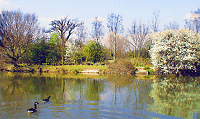|
The only village in Greater London that is outside the M25, and the most remote from the city centre, North Ockendon lies
two miles east of Corbets Tey. It is a scattered farming community with labourers’ cottages at its core on Church Lane.
The flint-faced church of St Mary Magdalene dates from 1175 and retains elements from the 13th, 14th and 15th centuries. Among
the monuments in the church are a number commemorating members of the Poyntz family, the former lords of the manor. In 1593,
John Morris married Katherine, daughter of Sir Gabriel Poyntz, and the couple jointly gained possession of the manor from
Katherine’s father. A descendant, another John Morris, was arraigned before the House of Lords in 1647 on charges of
forging various evidences, including Acts of Parliament, to secure his title to North Ockendon and other manors. A timber-framed
forge and bakehouse were built on Ockendon Road in the 17th century and survive today, as do cottages dating from around 1700.
The village became part of Hornchurch Urban District in 1935, hence its present inclusion within Greater London. North Ockendon
Hall was destroyed during World War II; its medieval moat is now part of Hall Farm. The farm is a flower nursery, while the
moat is popular with anglers. After decades of decline, North Ockendon is growing again, with the construction of St Mary’s
Court accompanying the restoration of the church in 2003. Havering’s outdoor pursuits centre Stubbers lies a mile to
the west, although the house that gave the estate its name was demolished in 1960. The much larger settlement of South Ockendon
falls within the district of Thurrock, in Essex.
William Coys, who lived at Stubbers in the early 17th century, did pioneering work with plants and vegetables. He introduced
hops as an ingredient in beer and cultivated exotic crops such as Jerusalem artichoke, ivy-leaved toadflax and the first yucca
to flower in England.
 |

